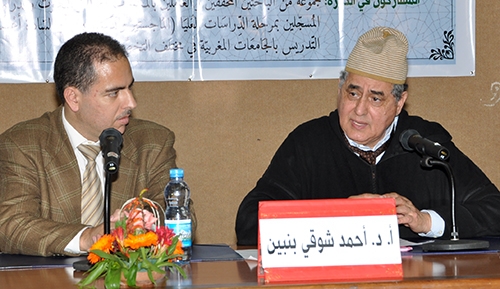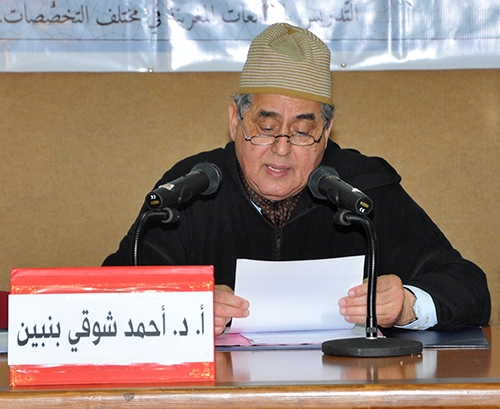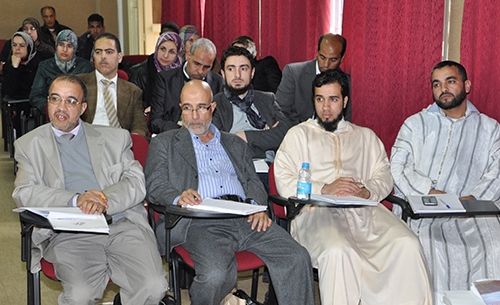Professor Ahmed Shawqi Binebine, a scholar of Islamic Codicology delivered an insightful lecture on “The Arabic Manuscripts in North Africa and sub-Saharan” at the Faculty of Arts and Humanities Ben M’sik, University of Hassan II in Casablanca, on 19 March 2013.
The lecture was introduced and chaired by the Dean of the Faculty, Professor Dr. Abdul Majid Quduri and Dr. Saeed Hishni, a researcher at the Royal Library (al-Khizana al-Malakiyya) in Casablanca.

Professor Binebine began his lecture highlighting the importance of the field and the repositories that had taken great care over history to preserve this heritage, such as old libraries, zāwiyas and ribāṭs. He drew the attention of the audience to the inextricable link between unearthing the history of a civilisation and the field of manuscript study. He then presented the history of Arabic manuscripts in North Africa, especially that of Morocco, Algeria, Tunisia, Libya and countries of the Southern Sahara. He also included in his presentation those manuscripts that had been written in local indigenous languages such as Hausa and Swahili, which had taken on the use of the Arabic script. He also pointed out that the codicological study of the field material had unfortunately not always enjoyed the support of researchers it needed. Added to this challenge, was the difficulty presented due to the geographical spread of the manuscript collections over large distances of the Southern Sahara.

After presenting his survey of Arabic manuscripts in North Africa, Professor Binebine moved to address the status of manuscripts in the South Sahara region. He talked of the factors that led to the appearance of these manuscripts, the most important being the spread of Islam in this area of the world post the sixth century of the Islamic calendar. This had been facilitated through commerce, whereby Muslim merchants interacted with the kings of sub-Saharan Africa, and through meetings held by scholars of the Sudan with their counterparts in Morocco and Egypt, in addition to their interaction during visits and trips to the Holy Lands. Through such meetings, centres of learning were beginning to be established and by the ninth century of the Islamic calendar, many regions had witnessed the creation of influential centres of research and study such as those founded in Wallatah in Mauritainia, Kano in Nigeria and Timbuktu in Mali. The centres drew much acclaim and recognition, attracting the visit of Al-Hassan al-Wazan al-Ghurnaṭī al-Fasī in the tenth century of the Islamic calendar.
The lecture also covered reasons for the loss of large collections of manuscripts such as through theft, arson and the material disintegration of the manuscripts. Another contributing factor was the colonial war, particularly since no policy towards the protection and preservation of this heritage was in place. Rather, a number of outsiders from the West had been involved in the damaging of this heritage. Some were deliberately burnt and some stolen and carried back to the West. Another contributing factor to the disintegration of some manuscripts was the hot climate and the successive droughts witnessed by the region. Some manuscripts had been buried in sand as their owners fled from colonial armies, while other collections had been passed on to those living in the harsh climate of the desert.
He reminded the audience of the first scholars to publish part of this heritage: The anthologist and linguist Maurice Delafosse (d. 1926) and illustrious arabist Octave Houdas (d. 1916).

He then presented an overview of the properties of African manuscripts and the materials used to make them. This included a discussion on writing materials such as card and tasfir and the types of inks, fonts and pens that were commonly used. A review of the most important efforts made in the indexing of these manuscripts then followed, whilst praising Al-Furqān Foundation, and the Foundation’s efforts and contribution to the field.
The lecturer also commended the efforts of the American researcher Dr. John Hunwick who wrote a momentous book of six volumes, of which four have been printed to date under the title “The History of Arabic Literature in Africa”.
In his conclusion, the professor said that unlike the manuscript heritage of North Africa, the Arabic heritage still lying in the South Sahara had not been carefully or properly researched by Orientalists. He added that the indices that have been developed to date were incomplete, and will remain incomplete as long as the field work necessary did not take into consideration all locations and tribes yet to be reached by researchers. He added that the few that have been discovered have proven to be insufficient to provide a clear and holistic picture of the cultural life of the south Sahara in the past three centuries. Indeed, even with codicological research which can often present pleasant surprises, this will only be possible when more manuscript material of this heritage becomes available for study.


